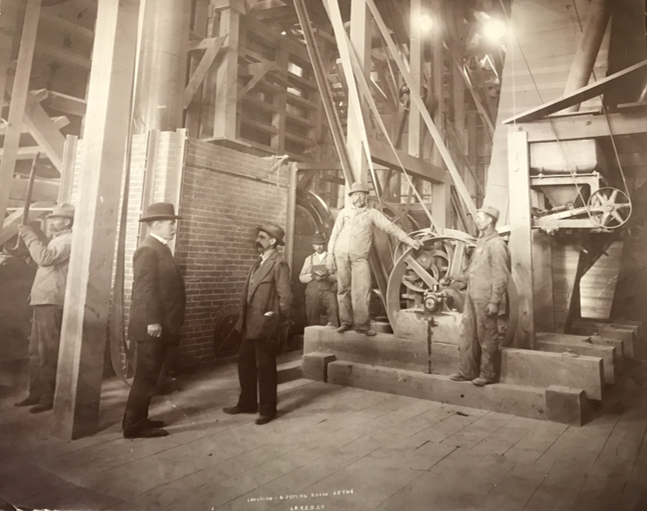
Colorado’s Silver Crash of 1893 is a good example of the necessity of strategic thinking – especially during times of booms and busts. My wife’s grandmother used to talk about the “bust times” by remembering Leadville’s famous Baby Doe Tabor who was seen walking the streets of Denver in the early 1900s with burlap bags covering her feet. She was a historic figure who was married to Horace Tabor, one of the richest men in the western United States in the early 1890s. In the late 1870s and early 1880s, Tabor acquired silver mines in Leadville, including the storied Matchless Mine that brought him great wealth. Their tale is one of social scandal, lavish spending, and poor judgment set against a backdrop of politics, macroeconomics, international banking, and mining.
Silver prices were the main driver of the Colorado economy at the time. Prices had been gradually declining after the Civil War but were propped up by the Bland-Allison Act of 1878 and the Sherman Silver Purchase Act of 1890. These laws required the Treasury Department to purchase silver to increase the money supply and stimulate inflation as a countermeasure to the broadly based deflation that was occurring. The increased demand for silver was also designed to support the mining industry in the western part of the country where silver was in oversupply.
The Sherman Act required the government to purchase 4.5 million ounces of silver per month as part of the “bimetallic” (gold and silver) financial system of the time. The Sherman Act was controversial as it went against international banking trends and incentivized people to cash in their silver certificates for gold, causing a precipitous drain on the country’s gold reserves. A pervasive fear arose among both investors and the general public that the United States would not be able to maintain the gold standard, the foundation of the financial system. This fear caused the hoarding of gold, halting of investment, and drying up of liquidity – the makings for the Panic of 1893.[1]
The Panic of 1893 became the worst financial downturn that the country had experienced as investors sold assets to buy gold and banks began calling in loans. Damage from the panic included the failure of 4,000 banks, 14,000 businesses, fifty railroads, and thirty steel companies. Unemployment increased to 20 percent with 2.5 million people moving from city to city searching for work. Wage reductions led to 1,300 strikes, widespread unrest, and substantial hardship.[2]
Meanwhile, the election of 1892 brought in the opposition political party and a new president – Grover Cleveland. Silver prices began to decline with the election in anticipation of repeal of the Sherman Act. Once the law was repealed, prices fell dramatically from 83 cents per ounce to 62 cents per ounce in a 4-day period.[3] Mines began to close, equipment contracts were canceled, and supply chain companies began to suffer. The pain in Colorado was so great that 30,000 miners and smelter workers lost their jobs. The city of Denver sank into a depression with four major banks failing in one day.[4] The depression also made the Tabors penniless.
Stearns-Roger was a manufacturing and engineering firm in Denver that was instantly affected by the silver mine closures. After the repeal of the Sherman Act, the company’s equipment orders were quickly canceled while other clients defaulted on their payments. An emergency board meeting was called to plan a strategy for dealing the rapid downturn. From an operational standpoint, the board and executive management decided to take pay cuts. From a strategic standpoint, the company sent out key staff to develop a new and adjacent market – the gold fields in Cripple Creek Colorado. Their “Cripple Creek strategy” was so successful that they eventually built most of the plants in the entire district.[5]

Strategic thinking can be simply thought of as finding a way through a problem. I have worked with many companies throughout my career that unfortunately developed detailed processes that culminated in intractable PowerPoint slide decks. Clearly, companies need a process to develop a plan and a medium (such as PowerPoint) to convey the plan. However, the form of the plan often overtakes the substance.
I recently facilitated a strategic planning workshop for a company that is reinventing itself. Our approach was to discuss their goals and then identify the gaps, barriers, and troubling issues that were limiting the company from achieving their goals. Serious strategic thinking is defined as finding ways to bridge these gaps, remove the barriers, or overcome the issues. The respected strategic thinker Richard Rumelt said if you don’t solve a problem, you don’t have a strategy. Instead, you have a stretch goal.
When working with companies, I like to combine the ideas of Rumelt and Michael Porter, another strategic thinker. Rumelt often compares strategic thinking to solving a puzzle with a top team of performers.[6] Porter stressed that the goal of sustainable profitability is based on providing services that customers value, in ways that are different from competitors – and that cannot be easily replicated. This last point is at the heart of the matter and is the reason why some companies are in business year after year.
A strategy needs to answer three questions:
- Does it solve a problem?
- Is it designed around competitive advantage
- Is it granular about where to compete?[7]
Looking back to the 1890s, Stearns-Roger could have done a better job of strategic planning. They had the competitive advantage with their equipment manufacturing for the mills, were granular about where to compete (specific mining fields). However, they should have been aware of the problem of changing political climate and the trends in silver prices. They could have mitigated a lot of damage by proactively shifting the business at an earlier date. Fortunately, they found their “silver lining” in the gold fields of Cripple Creek and continued to diversify and evolve to the early 1980s – when I joined the firm.
- Lauck, W. Jett. The Causes of the Panic of 1893. Houghton, Mifflin and Company, 1907, pp. 110-122. ↑
- “Panic of 1893. American Eras. Encyclopedia.com. (July 2, 2019). https://www.encyclopedia.com/history/news-wires-white-papers-and-books/panic-1893 ↑
- “Panic of 1893.” St. James Encyclopedia of Labor History Worldwide: Major Events in Labor History and Their Impact. Encyclopedia.com. 2 Jul. 2019 <https://www.encyclopedia.com>. ↑
- Turner, Carol. “The Panic of 1893 hit Colorado hard,” blog: https://caturner.wordpress.com/tag/bank-panic-in-colorado/ ↑
- Lane Jr., James M. Proud Journey: The Story of Stearns-Roger. Denver, Colorado, July 1976, Chapter IV, pp. 11, 12, 19. ↑
- Lovallo, Dan P. and Lenny T. Mendonca. “Strategy’s Strategist: An Interview With Richard Rumelt,” in The McKnsey Quarterly. August 2007 < https://www.mckinsey.com/business-functions/strategy-and-corporate-finance/our-insights/Strategys-strategist-An-interview-with-Richard-Rumelt?> ↑
- For more detail on testing strategies, see the classic McKinsey Quarterly article: Bradley, Chris, Martin Hirt, and Sven Smit. “Have you tested your strategy lately?” in McKinsey Quarterly. January 2011 < https://www.mckinsey.com/business-functions/strategy-and-corporate-finance/our-insights/have-you-tested-your-strategy-lately> ↑
